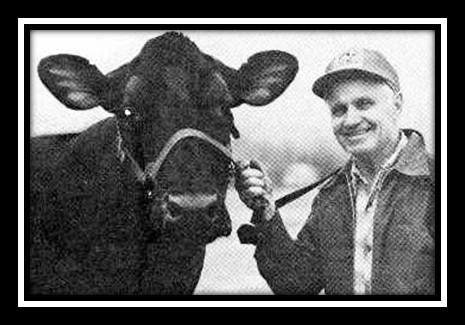
Advances in the laboratory methods for defining what feeds bring to the table in terms of nitrogen availability, intestinal digestibilities, and rates of passage. As we have drilled down into animal requirements and increased our precision and accuracy of animal performance predictions, the precision and accuracy of our laboratory assays and, consequently, our feed library values must correspondingly increase. Many of the feed library values in use have not been updated using newer analysis methods for N availabilities, amino acid efficiencies, and rates.
In keeping up with our increasing accuracy and precision of our understanding of animal requirements we have had to change how we think about nutrient requirements. Not only have we progressed in our thinking but we have also needed to change terminology and laboratory procedures to follow with the greater biological understanding. As a point, the cow has no requirement for Crude Protein (CP); she needs amino acids and nitrogen available at a rate complimentary to her carbohydrate sources. For this we need to have a clear understanding of the availability and flow rates through the rumen. We are reliant on library values for this information on most feeds. Those library values need to be the result of accurate and precise methodology that has kept pace with our understanding of digestion kinetics.
The model has evolved to the point where modeled predictions for Metabolizable Protein (MP) are very close to actual MP. Work by Chase et al, has shown effective formulation of low CP diets compatible with high production. Feeding excess protein is expensive going in and coming out. In order to be effective at spot-on formulation, we need a confidence in the feed library values. Accurate estimates of intestinal digestibility is very important to ensuring adequate supply of nutrients. Because of the noted variations in digestibilities and the small sample size Debbie Ross from the VanAmburgh group a Cornell developed a lab repeatable assay to supply updated in-vitro intestinal digestion (IVID) data for protein containing ruminant feeds.
Since the Tilley and Terry development of a two-step IV procedure (1963) there have been several modifications to refine the ID values with varying success and limitations. Boucher et al. (2009) utilized a very sensitive approach utilizing a precision-fed cecectomized rooster, however; this is not easily applicable to for routine laboratory analysis.
In a review in 1997, Stern et al. calculated intestinally absorbable protein from specific feeds as ruminally undegraded protein (RUP) multiplied by intestinal protein digestion. He stated that an IV technique to estimate protein digestion should utilize enzymes similar to those found in the digestive tract of ruminant animals and correlate only to intestinal digestion.

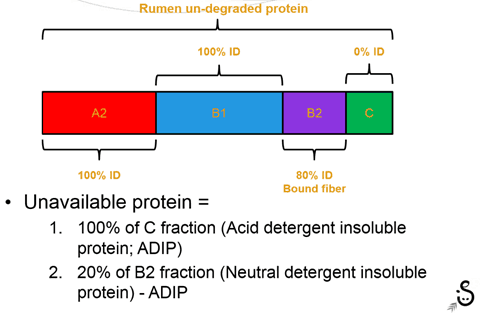
* Ross et al. 2013
The Ross Assasy was developed to address the following concerns with the existing procedures:
-
The use of bags
- Lag time for exposure to rumen microbes
- Feed loss—differentiation between digestion from bag loss
-
The enzymes Pepsin & Pancreatin
- The profiles and activities inconsistent
- Ruminant digestion is continuous flow of digesta with continuous secretion of enzymes
To resolve the inconsistencies the use of bags was abandoned and a physiological enzyme mix was employed. How is this important to CNCPS? In Ruminants intestinal digestibility is a calculation:

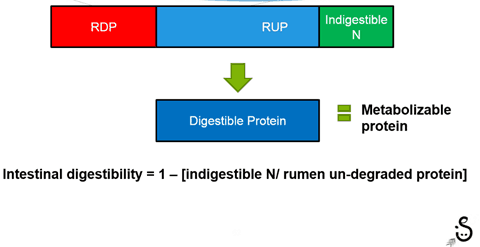
This chart shows a comparison of two sample using ADIN vs the uNRoss for characterizing In-vitro digestibilities.
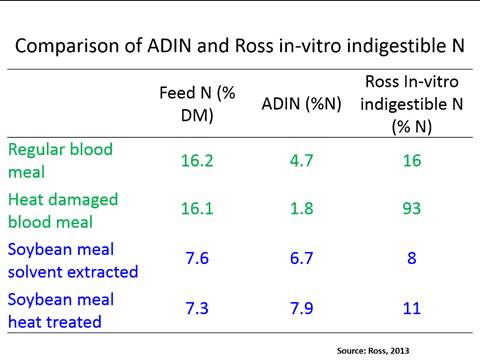
The significance of this data is well illustrated in this next series of graphs from Ross 2013 CNC proceedings.
Using the traditional ADIN method of analysing Nitrogen avalability, both regular blood meal and purposfully heat damaged bloodmeal would seem to have very similar digestible protein values.
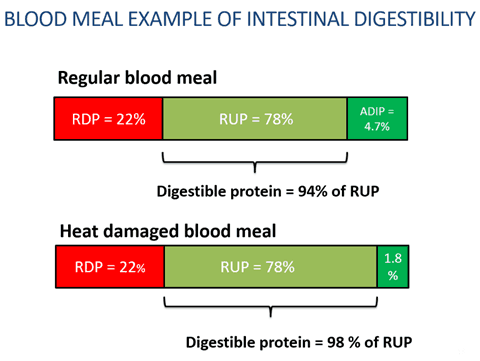
However, when analyzed using the uNRoss assay, the digestible protein values are very different.
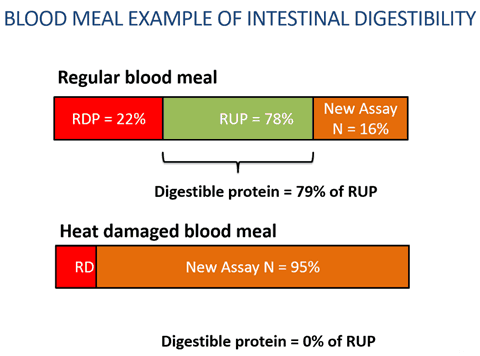

Using the uNRoss assay in the model yields very different predictions for MP allowable milk. In a cow study using 96 cattle approximately 147 days in milk, fed the same diets that varied only in blood meal characterization (low uN 9%, high uN 34). The calculated difference between the treatments was 20 g.
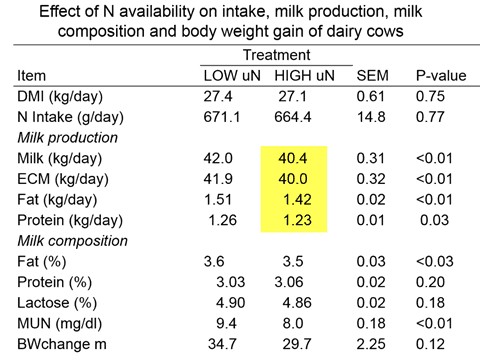
The significant difference in milk serves to emphasize how close our predictions are to actual animal performance. The assay provides reasonable and repeatable results able to be replicated in commercial labs. Going forward it recommended that the uNRoss assay be used to determine unavailable Nitrogen.
Images and figures in this post courtesy of Cornell University
